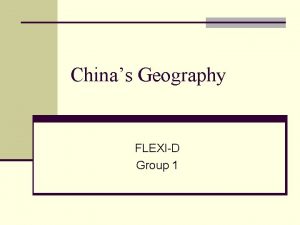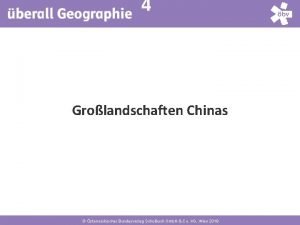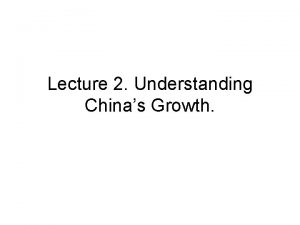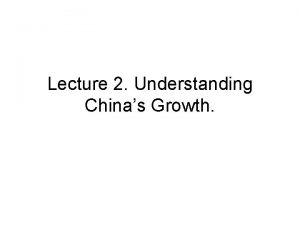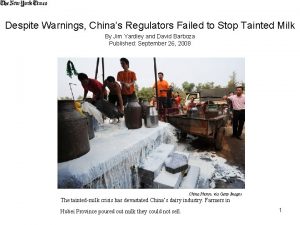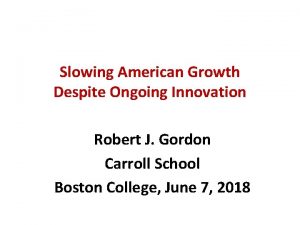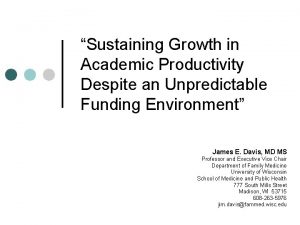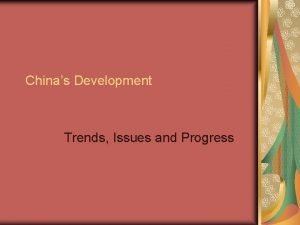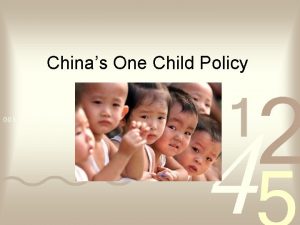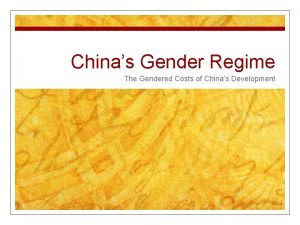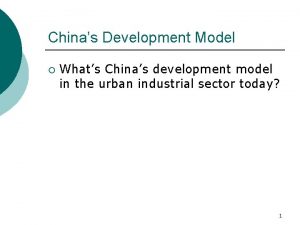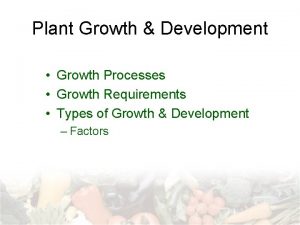Lecture 2 Understanding Chinas Growth Introduction Despite Chinas




























- Slides: 28

Lecture 2. Understanding China’s Growth.

Introduction. • Despite China’s remarkable growth, there is not much literature trying to explain its very high growth rates. • There is much speculation about the causes of Chinese economic growth and about predictions for the future. • Many of the data, especially from the past, are problematic and subject to criticism. • We are at a stage where we get mostly only macroeconomic estimates.

• Yt=At. F(Kt, Lt) • The big questions turn around • Kt (capital stock). Problem of valuation of socialist capital. • At (total factor productivity). • Lt also raises problems of its own (problems associated to one child policy)

Hu-Khan (1997) • IMF team report. • Kt grew by 7% between 1979 -94 but capital output ratio has remained more or less constant (no capital deepening). • Estimate TFP growth of 3. 9% in that period (compared to 2% for Asian tigers). Explain by success of reforms.

Chow-Li (2002) • Yt = Aet. Kt. Lt • Ln Yt = a 0 + a 1 ln. Kt + a 2 ln. Lt +a 3 t. 6136. 4118. 0263 (. 0772) (. 1996) (. 0025) • Trend only significant after 1978. • Suggests constant returns to scale (a 1 +a 2 not different from 1). • Ln (Yt/Lt) = a 0 + a 1 ln (Kt/Lt) +a 3 t. 5577. 03028 (. 0468) (. 0040)

Chow-Li (2002) • Suggests a 3% annual growth in TFP from 1978 to 1998. • Growth of 9. 1% can be decomposed in – 5% due to capital (. 5577 X 9. 1) – 3% due to TFP growth – 1. 1% due to labor [(1 -. 5577)x 2. 7] • Growth due mostly to capital accumulation and TFP growth (1/3 of growth explained by TFP growth). • Projections of 8% annual growth until 2010. Were not proven wrong.

Young (2003) Contrarian view critical of official statistics (1978 -1998). 1. Statistical Bureau reluctant to revise downward estimates. 2. Problems with reporting nominal and constant output by enterprises. Leads to underestimation of deflator by 1. 7 to 2. 5 %. 3. Proposes reconstruction of many data but with not too many differences. 1. 2. 3. 4. 5. Output per capita growth at 6. 1% (instead of 7. 8), output per worker at 5. 2% (instead of 6. 9) due to rising participation rates, non agricultural output per worker at 3. 6% (instead of 6. 1%) non agricultural output per effective worker to 2. 6% (instead of 5%), non agricultural TFP per worker at 1. 4 (instead of 3).

Perkins-Rawski (2007) • Try to predict growth over the next two decades. • Growth accounting: • TFP growth = g. Y – a. Kg. K -a. Lg. L • g. Y , g. K , g. L growth rates of GDP, capital and labor. • Shares of capital and labor a. K, a. L in total factor payments (in total national income).

Perkins-Rawski (2007) • Use official statistics. Accept possible deflator problems but also underestimation of service sector. Moreover, quality adjustments not applied in existing price indices. • Use 2000 prices to avoid inflated industrial prices from socialism. • Capital stock estimated using annual investment outlays and depreciation rate of 9. 6% (perpetual inventory method) • Labor measured as population 16 -65 and decomposing in 5 education categories (no diploma, primary, junior high, high school, college).

Perkins-Rawski (2007) • Inconsistencies between census and data on graduation. Build data using age-specific mortality rates and graduation rates. • L = L 1 + L 2 + L 3 + L 4 + L 5 • H = w 1 L 1 + w 2 L 2 + w 3 L 3 + w 4 L 4 + w 5 L 5 • wi are education-linked wage differentials. • H/L measures educational attainment.

Perkins-Rawski (2007)

Perkins-Rawski (2007)



• Japan’s postwar growth based on TFP growth. Half of 9% growth rate between 1950 and 1970 explained by TFP. Later slowdown associated to fall in TFP growth. • Question: Will the growth continue?

Low dependency ratio imply robust household savings

Projections of Working Age Non-Student Population Ages 16 -65: Size and Composition, 2005 -2025 Decline of L after 2015 but increasing human capital


It would take China 10 -15 years at least to reach PPP GDP per capita of $13, 000 ($5, 300 in 2007).

How productive is investment in China? • China has had a very high investment rate (around 40%). This suggests that the marginal product of investment might be low (too much investment and allocative inefficiencies). However, a very high marginal return to capital might explain a high investment rate. • Bai et al. (2006) have addressed this question.

How productive is investment in China? • Use revised output estimates after 2004 census (covers 1978 -2004). • Assume depreciation rate of 8 % for structure and of 24 % for machinery. Use estimate of initial stock for 1952 plus gross fixed capital formation. • Estimate share of capital income as residual of labor income.


How productive is investment in China? • Estimates relatively high even though falling. • Why have returns remained high? – Capital-output ratio has not increased much – Capital share has increased steadily together with increase in the investment rate.

How much misallocation of capital in China? • There is a strong perception that despite strong growth, there may be a severe misallocation of capital in China. • General idea: if distortions favor certain firms, they can survive with lower TFP than firms that do not benefit from those distortions. Hsieh and Klenow (2008).




Open questions • China’s growth will affect the global economy and there may be feedback effects. • Energy. • Environment.
 01:640:244 lecture notes - lecture 15: plat, idah, farad
01:640:244 lecture notes - lecture 15: plat, idah, farad Damas chinas instrucciones
Damas chinas instrucciones Whats chinas longest river
Whats chinas longest river China 4 großlandschaften
China 4 großlandschaften Großlandschaften china karte
Großlandschaften china karte Chinas physical features
Chinas physical features Chinas dynastys
Chinas dynastys Großlandschaften china karte
Großlandschaften china karte Regiones chinas
Regiones chinas National animal in china
National animal in china What is greece's national animal
What is greece's national animal De que color es el ave llamada pinzon purpura
De que color es el ave llamada pinzon purpura Ancient china on a map
Ancient china on a map What is growth analysis
What is growth analysis Monocot vs eudicot
Monocot vs eudicot Carothers equation
Carothers equation Primary growth and secondary growth in plants
Primary growth and secondary growth in plants Chapter 35 plant structure growth and development
Chapter 35 plant structure growth and development Geometric growth graph
Geometric growth graph Neoclassical growth theory vs. endogenous growth theory
Neoclassical growth theory vs. endogenous growth theory Organic vs inorganic growth
Organic vs inorganic growth Types of sentence openers
Types of sentence openers Mice and men chapter 1
Mice and men chapter 1 Using marketing information to gain customer insights
Using marketing information to gain customer insights Despite although
Despite although However despite
However despite An sentences
An sentences Expressing contrast example
Expressing contrast example Adverbs of concession
Adverbs of concession


